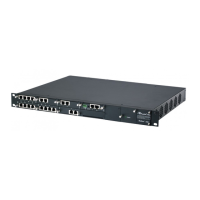Version 6.4 701 March 2012
SIP User's Manual A. Configuration Parameters Reference
Parameter Description
messages are tunneled using SIP INFO, and ISDN
Disconnect/Release message is tunneled using SIP BYE
messages. The raw data from the ISDN is inserted into a
proprietary SIP header (X-ISDNTunnelingInfo) or a dedicated
message body (application/isdn) in the SIP messages.
Notes:
For this feature to function, you must set the parameter
ISDNDuplicateQ931BuffMode to 128 (i.e., duplicate all
messages).
ISDN tunneling is applicable for all ISDN variants as well as
QSIG.
Web/EMS: Enable ISDN Tunneling
IP to Tel
[EnableISDNTunnelingIP2Tel]
Enables ISDN Tunneling to the Tel side.
[0] Disable (default)
[1] Enable ISDN Tunneling from IP to ISDN
When ISDN Tunneling is enabled, the device extracts raw data
received in the proprietary SIP header, x-isdntunnelinginfo, or a
dedicated message body (application/isdn) in the SIP message
and then sends the data in an ISDN message to the PSTN.
If the raw data in this SIP header is suffixed with the string
"ADDE", then the raw data is extracted and added as
Informational Elements (IE) in the outgoing Q.931 message.
The tunneling of the x-isdntunnelinginfo SIP header with IEs is
converted from INVITE, 180, and 200 OK SIP messages to
Q.931 SETUP, ALERT, and CONNECT respectively.
For example, if the following SIP header is received,
x-isdntunnelinginfo: ADDE1C269FAA 06
800100820100A10F020136 0201F0A00702010102021F69
then it is added as an IE to the outgoing Q.931 message as
1C269FAA 06 800100820100A10F020136
0201F0A00702010102021F69, where, for example, "1C269F"
is a 26 byte length Facility IE.
Note: This feature is similar to that of the AddIEinSetup
parameter. If both parameters are configured, the x-
isdntunneling parameter takes precedence.
Web/EMS: Enable QSIG Tunneling
[EnableQSIGTunneling]
Enables QSIG tunneling-over-SIP for all calls. This is according
to IETF Internet-Draft draft-elwell-sipping-qsig-tunnel-03 and
ECMA-355 and ETSI TS 102 345.
[0] Disable = Disable (default).
[1] Enable = Enable QSIG tunneling from QSIG to SIP and
vice versa. All QSIG messages are sent as raw data in
corresponding SIP messages using a dedicated message
body.
Notes:
You can enable QSIG tunneling per specific calls by
enabling QSIG tunneling for an IP Profile.
QSIG tunneling must be enabled on originating and
terminating devices.
To enable this function, set the
ISDNDuplicateQ931BuffMode parameter to 128 (i.e.,
duplicate all messages).
To define the format of encapsulated QSIG messages, use

